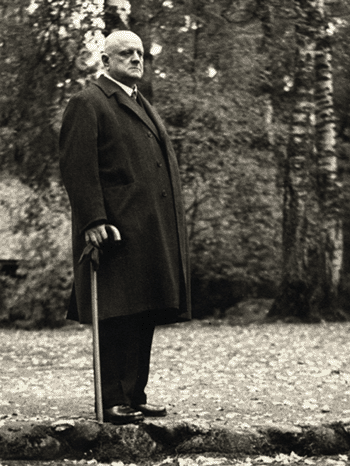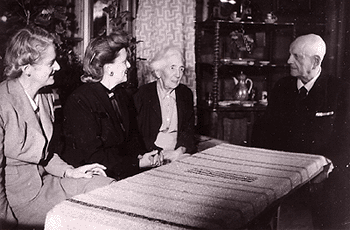In the summer of 1939, the Sibeliuses were planning major changes in their living arrangements, as Aino Sibelius was longing to see more of her daughters in the city. The Sibeliuses rented an apartment in Helsinki, in Kammiokatu in Töölö district, and they moved from Ainola at the end of September. However, a couple of weeks later the inhabitants of Helsinki were asked to send their children away from the capital because of the threat of attack from the Soviet Union. Sibelius decided to return to Ainola, where he acted as host for his daughters and their families who had fled the war.

The Winter War broke out on 30th November 1939, when the Soviet Union attacked Finland. Sibelius was offered asylum in the United States and the Nordic countries, but the patriotic composer refused. "These foreigners do not understand that a Finn does not leave his country at the moment of danger," Aino Sibelius commented.
When the Winter War ended in a temporary peace, with Finland having to cede territory, the family once again considered moving to the city. The move took place in the autumn of 1940. Aino Sibelius often went to the theatre, and she frequently met the families of her daughters. But the noises of the apartment irritated the composer, even though he enjoyed his walks by the sea.
It was in Kammiokatu that Sibelius's 75th birthday was celebrated. The composer could not be persuaded to attend the official celebrations.
Did Sibelius compose anything in Kammiokatu? The composer Einar Englund heard from his tutor Martti Paavola that Paavola had visited Kammiokatu in 1940, and that he had been allowed to look into Sibelius's safe. Paavola recollected that the safe contained "several scores, one requiem, one symphony, most likely the eighth, and also some symphonic poems".
In June 1941, relations between Finland and the Soviet Union once again became so strained that people were again asked to take their children away from Helsinki. Once again the Sibeliuses moved to Ainola to take care of their grandchildren. This move turned out to be final. The apartment in Kammiokatu was still used for another eighteen months whenever the Sibeliuses needed to stay in the city for the night. It was finally vacated in 1942. "I think it was quite a good hotel," Sibelius commented later. Today, Kammiokatu is known as Sibeliuksenkatu (Sibelius Street).
The war known to Finns as the "Continuation War" started only a few days after the move back to Ainola. Sibelius's income from abroad was cut off, and food rationing made life more difficult. The produce from the Ainola vegetable garden was needed in order to maintain a varied diet for the aging spouses and their daughters' families.
Sibelius's international reputation suffered a blow in the spring of 1942, when Joseph Goebbels, who was responsible for Nazi propaganda, founded a Sibelius Society in Germany. The intention was to strengthen the cultural relations between the two countries who were fighting against the Soviet Union. The initiative may have come from the Finnish Ministry of Foreign Affairs. Sibelius thanked Germany for the honour, even if his attitude towards the Nazis was unenthusiastic: he condemned National Socialism and its racial doctrines in his diary over a year later, in September 1943.
In Sibelius's radio greetings to Germany he speaks of the destiny linking the two countries, but places the emphasis on Germany as "the glorious land of music". The composer sent his daughter Ruth to the inauguration of the society.
Sibelius's radio greetings to Germany
Radio greeting to mark the foundation of the Sibelius Society in Germany in 1942, with rehearsals. Three takes.
Sibeliuksen radiotervehdys Saksaan.mp3
Sibeliuksen radiotervehdys Saksaan_56k.rm
Sibeliuksen radiotervehdys Saksaan_isdn.rm
The foundation of the society attracted unfortunate attention in Western countries and adversely affected the status of Sibelius's music in post-war Germany.
During 1942, Sibelius put the finishing touches to new arrangements of his Christmas Song and High are the Snowdrifts. He had not given up his dream of finalising the eighth symphony. "I have a great work under way and I would like to get it ready before I die," he told his secretary in February 1943. "But the inhumanity of the war hinders my work. I cannot sleep at nights when I think about it."
In June 1943, Sibelius once again spoke to Jussi Blomstedt (later Jalas) about his new work. "For each of my symphonies I have developed a special technique. It can't be something superficial, it has to be something that has been lived though. In my new work I am struggling with precisely these issues." During the same conversation, Sibelius spoke ominously of his drafts. "Remember that all my rough sketches must be burned after my death. I do not want anybody to write 'Sibelius letzten Gedanken' [Sibelius's last thoughts] or something like that." Jussi Jalas always wrote down the fragments of conversation with Sibelius that he considered important on the very same day they were uttered.
The only work that Sibelius completed in 1943 was an arrangement of The Rapids-Shooter's Brides.
In September 1944, Finland and the Soviet Union concluded an interim peace, which turned out to be permanent. In the same month, Aino Sibelius wrote to her friend Lina Boldemann about the life of her husband.
"He goes for a walk several times a day, and when he - thanks to his disposition - manages to forget all the difficult and distressing things for a moment, he is absolutely charming, just the way he can be, as you well know," Aino wrote.
As late as February 1945, Sibelius spoke to his son-in-law Jussi Jalas about "a great work in the making", probably the eighth symphony. But in 1945, the struggle for the fate of the symphony apparently ended. In August 1945 he mentioned that he had "completed" the symphony many times, and also burnt it once. A few days later, almost the same words appeared in a letter written to the conductor Basil Cameron in London, but with the sentence about the burning omitted.
Aino Sibelius confirmed that "in the 1940s" there was a great burning party at Ainola, with a bunch of Sibelius's manuscripts being used as kindling. Ruth's son, Erkki Virkkunen, visited the house soon after the burning and noticed how shocked his grandmother appeared. Sibelius himself spoke calmly of the matter to his grandson, in an almost jocular way. The burning of the manuscripts seemed to ease his mind. "After this, my husband appeared calmer and his attitude was more optimistic. It was a happy time," Aino Sibelius recalled later.
Sibelius composed some works after the burning took place, despite his shaking hands and cataract-ridden eyes, using manuscript paper with extra large staves. But now most of the compositions existed only in the wishes and thoughts of the aging composer. The silence of Ainola had begun.

Katarina Ilves, Ruth Snellman, Aino and Jean Sibelius in Ainola towards the end of the Second World War.



